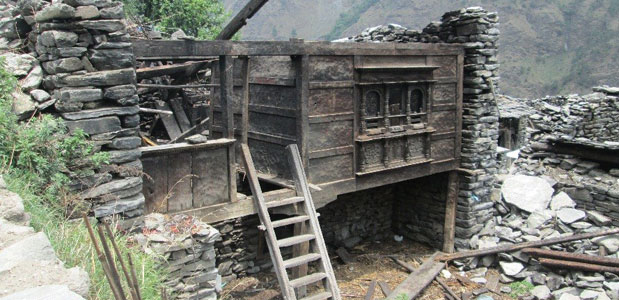 House damaged by the 2015 earthquake
House damaged by the 2015 earthquake
Recently we has a field visit to Gatlang, (upstream of Gandaki River Basin, HI-AWARE study site) located in the western part of Rasuwa district, outside Langtang National Park, at an average altitude of 2238 metres. The village, consisting of 400 households, is almost exclusively inhabited by Tamangs. The compact settlement comprises traditional Tamang farmhouses, i.e. two-storied stone-wood constructions with wooden roofs and carved windows, which had been completely destroyed by the Gorkha earthquake. Some people have managed to cover their roofs with galvanized sheets in order to protect what is left of their homes. Meanwhile, the people are living in temporary shelters, often around their original settlement.
Agriculture is the main source of livelihood in Gatlang. The major crops grown include maize, finger millet, barley, buckwheat, potato, beans, black lentils, and vegetables. The current settlement and upper Gatlang are suitable for growing potatoes and beans whereas the lower lands are suitable for millet, barley, and maize. Potatoes are sown in March and harvested in August while beans are sown in August and harvested in December. In the lowlands, millet is sown in June/July and harvested in December. Maize is sown in March and harvested in September/October. Some villagers grow apples, peaches, and plums as well. In the last two to three years, 10 to 15 households have even started the commercial faming of Chiraito (Swertia chirayita) on small plots of land in shaded regions where there is little sunlight. Overall, the main exports are potatoes, beans, and livestock. The average agricultural land holding is a little over an acre, and villagers still practices parma, a culture that relates to the reciprocal exchange of labour.
The household food production is barely sufficient for six months. Animal husbandry – mostly chauris (yak and cow hybrids), goats, and sheep – is another major livelihood option for the people. There are around 38 herders who sell milk to the local cheese factory, selling at least 350 litres per day during the dry season. Those who raise animals also sell livestock to local traders who transport the animals to Kathmandu/Trishuli during the festival seasons.
Beside farm-related activities, women are engaged in weaving and preparing wool for those households that produce radi and pakhi, homemade caps and bags. A few people are also engaged in the tourism industry, as Gatlang is a major destination on the Tamang Heritage Trail. Additionally, older villagers and youths who can identify non-timber forest products are engaged in the collection and trade of medicinal plants. More recently, the youth have become involved in trade and commerce, as the trade route between China and Nepal has become more functional.
Another important source of income for the locals is the shares that have been issued by the Chilime Hydropower Company. The hydropower has provided ten percent of its shares to Rasuwa locals, which has contributed towards the economic security of households in the area.
Labour migration for foreign employment is emerging as an attractive livelihood strategy in Gatlang. Mostly, it is people from Grae village who migrate as labourers to the Persian Gulf and Malaysia. Around 70 individuals (60 men and 10 women) are currently abroad. The major push factor for this labour migration is poverty. Environmental stressors – rainfall variability, increase in temperature, decrease in snowfall duration and intensity, increase in wind speed and duration, thunderbolt, landslides, etc – have resulted in low agricultural productivity, thereby triggering migration.
